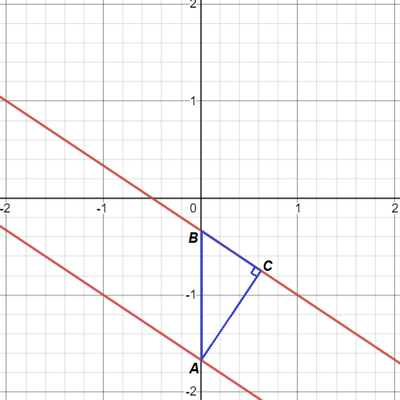Perpendicular distance between two parallel lines
Two parallel lines are given by 2 x + 3 y + 1 = 0 and 2 x + 3 y + 5 = 0 . What is the perpendicular distance between the two lines?
This section requires Javascript.
You are seeing this because something didn't load right. We suggest you, (a) try
refreshing the page, (b) enabling javascript if it is disabled on your browser and,
finally, (c)
loading the
non-javascript version of this page
. We're sorry about the hassle.
2 solutions
Distance between point and line
Both lines have a slope of − 3 2 , but the first line has a y -intercept of − 3 1 and the second line has a y -intercept of − 3 5 .
Draw △ A B C as follows:

Since the two y -intercepts are − 3 1 and − 3 5 , A B = − 3 1 − − 3 5 = 3 4 .
Since both lines have a slope of − 3 2 , the ratio of B C to A C will be 2 : 3 , so let B C = 2 k and A C = 3 k .
By the Pythagorean Theorem, ( 2 k ) 2 + ( 3 k ) 2 = ( 3 4 ) 2 , which solves to k = 3 1 3 4 .
The perpendicular distance is then A C = 3 k = 1 3 4 .
The perpendicular distance between l 1 and l 2 is the distance between point A and line l 1 . d = 2 2 + 3 2 ∣ 2 ⋅ ( − 1 ) + 3 ⋅ ( − 1 ) + 1 ∣ = 1 3 4 Therefore, the perpendicular distance between the lines 2 x + 3 y + 1 = 0 and 2 x + 3 y + 5 = 0 is 1 3 4